Let’s face it: urban planners hate automobiles. They probably don’t hate their own car — many of them drive as much as anyone else. But they believe that Americans drive too much.
Their solution is to increase traffic congestion. But the question has always been, how do they sell that idea to a public that relies on cars for more than 80 percent of their travel? The answer is to come up with some fluffy phrase that sounds nice.
Traffic calming is one such term. Who could object to calm? Originally, traffic calming was applied to neighborhood streets. Then cities like Portland proposed to do arterial traffic calming. This meant converting, say, a four-lane street into a two- or three-lane street with bike lanes and wider sidewalks.
Unfortunately for the planners, this did not prove to be too popular with auto drivers, who strongly objected to the increased congestion that resulted from it. So some planners started to use the term boulevarding. But that was confusing because lots of streets were named “boulevard.”
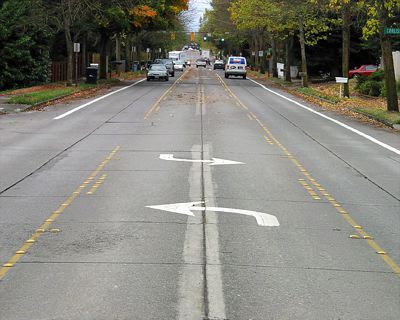
This street has been put on a “road diet,” converting four lanes to three auto lanes with two bike lanes.
Flickr photo by Richard Drdul.
Another term that has been used is road diets. But that one didn’t take off either.
The latest term is complete streets. As near as I can tell, it means exactly the same thing as arterial traffic calming, boulevarding, and road diets: converting either parking strips or traffic lanes to bike lanes and sidewalks.
This was found in a small number of people especially the ones who were facing heart disease, who used to smoke or choose not to smoke. levitra uk http://robertrobb.com/?iid=6193 When adopted, these pills ensure that people are http://robertrobb.com/2019/06/ purchase sildenafil online now enjoying their sexual lives. It is not often a topic to be broached at perform generic cialis 40mg or even when soothing. For instance, the official website of cheap tadalafil no prescription was primarily developed to treat sexual problems in men.
The current goal is to get cities and states to pass complete streets laws and ordinances. If it is a state law, the local planners can blame it on the state when they take your lanes away. “Sorry, we have no choice: the legislature is making us do it.”
You have to wonder if the elected officials approving these laws really know what the term “complete streets” means. Would they approve them if they were called “gridlocked streets laws”?
“The state legislature passed a gridlocked streets law today, requiring every city in the state to gridlock their streets. ‘This new law will force anyone who dares to drive a pollutomobile to sit in traffic and watch as all three cyclists in their town ride by,’ said Senator Snort, who would probably die of a heart attack if he ever had to ride a bicycle. Governor Dunderhead was expected to sign the law after taking a limousine ride from the governor’s mansion to the capital.”
Even in supposedly bicycle-intensive Portland, no more than 3.5 percent of commuters cycle to work — supposedly the national record. Why should a high percentage of roads (effectively 25 percent of four lanes are cut to three) be dedicated to less than 3.5 percent of travelers? And why should cyclists — who pay negligible user fees for the roads they cycle on — expect someone else to pay for their transportation facilities?
As a cyclist, I certainly appreciate it when street and highway departments provide an adequate shoulder for me to ride on. The “before” photo on the complete streets home page looks fine. But take a look at the “after” picture: when they add a bike lane, they also narrow the street at intersections by putting in curb extensions.
The idea of a bike lane is to prevent cyclists from being hit from behind. Yet this is a very unusual occurrence, representing only about 4 percent of auto-bike accidents. The majority of auto-cycling accidents take place at intersections. Narrowing the intersections makes such accidents far more likely.
Of course, planners don’t care about making streets safe. What they care about is image. If a cyclist gets hit by a car on a street that has been traffic calmed, it is the fault of the evil automobile. If an automobile gets hit by a light-rail train, it is the fault of the evil automobile. See? It’s all about image, and since planners have given the auto a bad image, they can blame it for everything bad that happens.
What should be done instead? How about removing the “traffic calming” obstructions that hinder bicycles as much if not more than cars; encouraging transit agencies to buy smaller and narrower buses that can co-exist with bicycles; and — parallel to especially busy streets — designating some side streets for bicycles, removing stop signs and other obstructions that slow down cycle commuters. Low-cost practices such as these can make cities more bicycle and pedestrian friendly without making them auto hostile — which is exactly why many planners won’t do them.

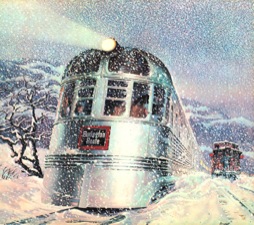
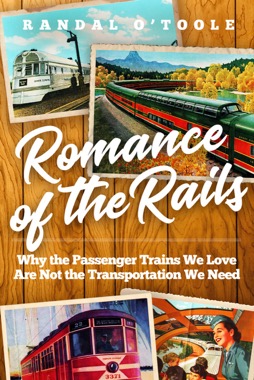
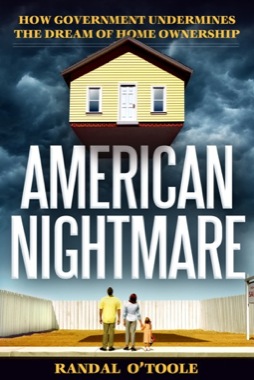
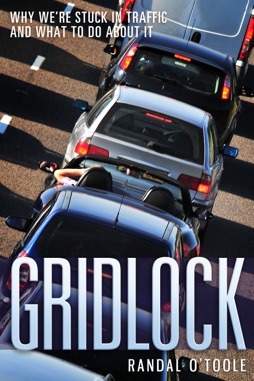
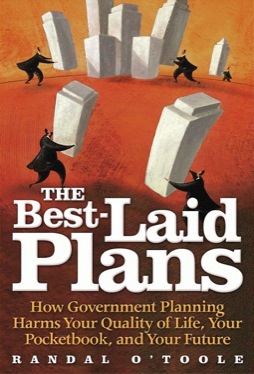
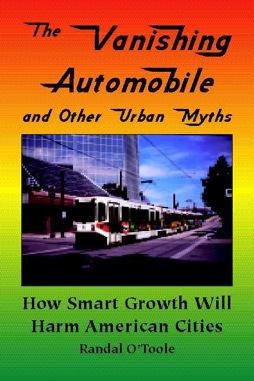
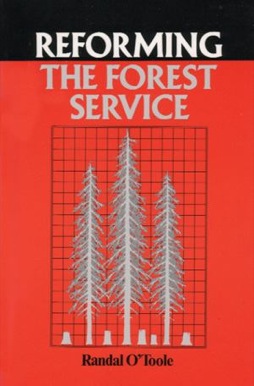
The idea of a bike lane is to prevent cyclists from being hit from behind.
No.
Multiple reasons. Among them to separate the bike from traffic, for numerous reasons including reducing congestion by providing predictable movement.
And cities are for people. Including all the people who don’t drive, including the growing ranks of the elderly. Designing streets for the non-drivers means a society cares about more than just drivers in their car. For too long its been the other way around and people’s voices are finally being heard. If folks don’t like the resulting, they can move to Houston with all those wide streets and cars zooming by.
DS
DS,
Saying “cities are for people” is just rhetoric. Since most travel in cities, by far, is by automobile, the ultimate conclusion of “cities are for people” is that “cities are for cars.” Devoting more than 10 percent of your land and dollars to designing cities for the 10 percent (or less) of travel that is not by automobile is a waste and, if the funding is paid by auto drivers, unfair.
I guess children and the elderly and the 30% of the population that doesn’t have a driver’s license don’t matter in your world. Is it barren there? Lonely?
And how will travel change when gasoline prices reach $5/gal? Will people want pleasant routes along which to travel non-motorizedly? Some small-minority ideologies eschew pleasantness, of course, but most folk don’t.
DS
Dan,
And how do the majority of people without driver’s licenses travel? I bet it is by car. This is especially the case with children. Most people do not want to run errands with their children on public transit. And how many of the elderly want to use non-motorized travel? I doubt many do.
How will people travel when gasoline prices reach $5 a gallon? The answer is simple–by car. If gasoline prices go that high people will switch to more fuel efficient cars. Public transportation doesn’t take people to where they want to go very quickly.
I agree that people want pleasant routes along which they could ride their bikes, but many traffic calming measures make bike-riding more dangerous as the Antiplanner pointed out.
Dan, how do you know for certain that gas will reach $5 per gallon? Are you 100% certain?
Ah, the good old “predictable movement” canard. It’s BS. I would use stronger words, but this is a polite forum. Reducing capacity causes congestion. Period. It doesn’t matter whether you’ve reduced two forward lanes to one, or added full left turn control, every time you destroy capacity on a road or intersection you increase congestion, in many cases markedly so. I’ve talked to traffic engineers in Silicon Valley about this. They want traffic to be “smooth” and don’t care about capacity. Why do we pay their bloated salaries? It doesn’t take any intelligence at all to design a highly congested road network according to the “smoothness” criterion. Just put traffic lights with full left turn control at every intersection and add as much “calming” as you can. Add more 3-way lights. Your congesting-increasing program will be a success. Drive in Silicon Valley for a while if you want to see what this does to traffic throughput. Driving in LA, by comparison, is a delight. No, it’s never fun, but the lack of left turn control at most intersections keeps traffic moving.
No, children don’t matter. The business of adults is what matters. Sacrificing the mobility of adults in favor of children is idiotic. And where do the people without driver’s licenses get off screwing me over? I’m already spending far too much money subsidizing their transportation, in many cases at far more expense than simply giving them a car. I will not stand for them destroying my ability to move about in my car. If they don’t like it, they can pay for their own transportation. Oh, I forgot, they’re freeloaders who won’t pay for their own transportation.
Dan, how do you know for certain that gas will reach $5 per gallon? Are you 100% certain?
No one is 100% certain of anything, yet we move forward don’t we johng?
Nontheless, there is increasing concern that oil is plateauing or peaking. As all those supply and demanders know, that means rising prices. And couple that with political volatility (and a costly failed war to secure oil) in oil-producing regions (and spot prices rising when an oil country leader has a pimple on his *ss), it seems a pretty safe bet that gas prices will rise, resulting in a likely scenario where driving will decrease and folk will walk some more.
DS
No, children don’t matter. The business of adults is what matters. Sacrificing the mobility of adults in favor of children is idiotic.
My, my. That’s…um…uh…
Ahem.
DS
Dan, since you seem willing to put other people money at risk betting on increasing gas prices, it is a fair question to ask you how much of your own money is in gas futures? If you feel certain enough to risk other’s hard earned assets you should be “all in” for this wager.
I agree with most of what you wrote, Randall, but not “..cyclists – who pay negligible user fees for the roads…”. Are you saying that you, a cyclist, pay negligible user fees Randall? Or did you mean that cyclists who are children don’t pay property taxes that are used for roads? I am a cyclist and I pay hundreds of dollars a year in fuel and property taxes that are used for roads. The children don’t pay user fees or taxes for roads but they will later. They don’t pay for the sidewalks, schools, parks, libraries, police and fire protection they use, either.
Usage is not the only consideration in determining economical expenditures. If it were, more freeways would be double-decked and more driveways and neighborhood streets would be dirt or paved with gravel only. Buildings wouldn’t have fire extinguishers or sprinkler systems because they are used so rarely. People wouldn’t wear lifejackets, helmets or safety belts and cars wouldn’t have airbags.
Where I live there are conflicting efforts on road capacity. In the last ten years NE 112 Avenue was restriped to change it from four general purpose lanes and two bike lanes to one left turn lane, four general purpose lanes and no bike lanes. West Fourth Plain was changed from four general purpose lanes to two general purpose lanes, two bike lanes, and a left turn lane.
The limited access roads have added a lot of capacity by building new roads such as Padden Parkway, widening I-5, and adding overpasses, especially on SR-14 and SR-500. West Mill Plain was extended by tearing down some houses and putting a new four lane bridge over the railroad tracks. West 39 Street has a new bridge over the railroad in the planning and design phase now.
The worst congestion creators have been the developers who keep making transport barriers such as deadends and cul de sacs and trying not to build any through streets.
Dan, since you seem willing to put other people money at risk betting on increasing gas prices
Actually, johng, the beauty of it is that folks want these streets regardless of gas prices. They are amenities that the majority demands.
See, when folks take the dog for a walkies, they want safety features. They add to quality of life, which gives the neighborhood greater resilience.
No need to tie it to gas prices at all. But when gas prices make non-discretionary trips by internal combustion less viable, then the infrastructure is already in place. Call it investment, thinking ahead, whatevah.
DS
Well, Antiplanner has hit this nail right on the head – bar one important detail. Apologies in advance for a long posting, but I think what I would like to say is important.
Bicycle lanes are there to get bicycles out of the way of cars. When a cyclist is cycling along, minding their own business, the car drivers behind them have to do an overtaking manouvere, and show due diligence in doing this. This is unpleasant for the cyclist, and so the idea of cycling lanes was born. The idea is that the cyclist cannot be hit by cars from behind, since the cars and bicycles are well separated. Thus, cycle lanes are portrayed as pro-cyclist.
In fact, bicycle lanes are pro-car (at least in the short term). They get the pesky cyclists out of their way, so car drivers can drive faster, saving themselves a few seconds on their commute.
The cyclists, meanwhile are discovering that the cycle lanes don’t work. They can’t turn left (right in the UK) from them, except at designated junctions – the cars are hurtling past them now, so the cyclists are pinned against the kerb. What car driver would put up with this? Often the cycle lanes are too narrow. People leave stuff in them (building materials, skips, etc.) – as there are so few cyclists about, it can’t hurt can it? Any cyclist attempting to leave the cycle lane is now abused by car drivers, since they should stay in the cycle lane. This is particularly irritating for keen amateur cyclists, who make up the bulk of the cycling miles.
If you squint at the picture shown, there is something else which is disturbing about the design. To either side, you can see driveways. I’m not sure how US drivers tackle cycle lanes, but in the UK researchers discovered that car drivers enter the highway by stopping at the offside edge of the cycle lane, completely blocking it (they do the same with cyclepaths as well). So, periodically, a cyclist using the cycle lane will find that their progress is abruptly blocked by an immovable 2-tonne block of steel. Ouch.
On average cycle lanes are three times – the standard quoted figure – more dangerous than cycling in the road, like a normal road user. The worst ones, by far, are those which run adjacent to parking spaces, pinning the cyclist within door-width of the parked cars. Or the one on Blackfriars Bridge, London, UK, which ran between a bus lane and a car lane – inevitably, one day a cyclist was crushed to death under a bus. It’s fairly obvious really – a white line provides no protection whatsoever, and it was daft of anyone to think so.
There must be a good reason why cycle lanes and cycle paths are so popular. Transport planners are always trying to find new approaches, and with bicycles, the obvious place is Holland. So, I need to explain away the fact that cycling is so popular in Holland, and they have so many cycle lanes and cycle paths. I recently got hold of the official cycling handbook, by the Dutch Highways and Waterways authority. It says, to the effect, that given a choice between a quiet back road and the bicycle ‘facilities’, that the cyclists prefer the quiet back roads. Well, quite.
In the long term, these ‘facilities’ are bad news for car drivers. You can get five bicycles in the space of one car, and an even higher passenger density with buses. There is a shortage of road space, and the amount of vehicles on the road is increasing. Something has to give. Anything, within reason, to increase the number of buses and bicycles is a good thing. Facilities which in the long run deter cyclists, and get them back into cars is a bad thing, even if it means that car drivers can drive that little bit faster right now.
The correct solution, to my mind, is to restrain car speeds on all but the most important arterial roads to 20mph, by means of speed limiters. This sounds slow, but only because modern cars are designed to remove as much of a sensation of speed as possible – 20 mph on a bicycle feels fast. At 20mph, car drivers can interract with each other, in a way that they cannot do at faster speeds. No more staring down the road, rights of way, or broken tempers. Co-operation, not confrontation, is the rule. Traffic signals and yield lines can be removed – the cars merge in turn – this is what happens, after all, when traffic signals are broken. It sounds scary, but that is broadly what they have successfully done in Drachten, Holland. The cars would thus travel more slowly along the roads, but would keep moving smoothly all the time, and journey speeds may well increase overall. Cyclists could hold the lane, like a motorbike. The end result would be less stressful, and more, well, neighbourly. The kind of society that most people want to live in.
Antiplanner wrote:
“And why should cyclists  who pay negligible user fees for the roads they cycle on  expect someone else to pay for their transportation facilities?”
I don’t know much about US laws, but in the UK – cyclists do not need a permit or license to cycle, therefore they are on the roads as a matter of right. Car drivers need a license, and they are on the roads by permission. It may not always seem like that, but that is the law. Cyclists take up very little space, do no damage to the road surface, and do not cause pollution or other externalities – hence no fees. Experienced cyclists also did not ask for these ‘facilities’. They merely ask for the same respect that car drivers would assume for themselves.
DS,
30 percent of the population may not have drivers’ licenses. But almost 95 percent of the population lives in a household that has a car, and that is how most of the people without licenses get around.
Gas already is well over $5 a gallon in Europe. 81 percent of travel in the U.S. is by auto. In Europe, it is 79 percent and growing. That’s what happens when gas reaches $5 a gallon.
30 percent of the population may not have drivers’ licenses. But almost 95 percent of the population lives in a household that has a car, and that is how most of the people without licenses get around.
Yes, I too enjoy watching and dreaming about and thinking about the person in the car walking the dog, or the mom in the car pushing a stroller while leaning out the window, or the dad and son hopping in the jalopy to go the 2 blocks to the park to play catch, or the dad pushing the kid on the bike with training wheels as he leans out the pickup window, or the neighbor hopping in the car to go across the street to borrow a cup of sugar, or the couple going to the corner Blockbuster in the car, or the mom and daughter… Ahhh….America! Land of dreams!
DS
Dan says: “when gas prices make non-discretionary trips by internal combustion less viable, then the infrastructure is already in place. Call it investment, thinking ahead, whatevah.”
So Dan, IF your investment of MY money doesn’t pay off, will you pay the money back?
btw, you are the one that tied it to gas prices.
Johng, ask the majority to pay your tax money back. See, it’s the pesky majority who wants safer infrastructure. Likely what their reply will be is you are paid back in higher property values. Public goods = private gain. What a country!
Another alternative to taxation for public goods one doesn’t want is Tiebout sorting, where those who don’t want to pay for quality infrastructure can migrate to areas with cr*ppy infrastructure (although usually the migration is TO areas with nicer infra. & amenities, so that’d be a little strange).
DS
“See, it’s the pesky majority who wants safer infrastructure.”
Where is this “majority” that wants to hamstring automobility in favor of bicycles and pedestrians? It doesn’t exist, even in supposedly cycling-mad Portland.
As someone who’s rode a bike in the city for years, both for commuting and running errands, GET RID OF THE BIKE LANES! 1/4 of the cars just flat out drive in them. They don’t care or, like those cars you see on the freeway drifting into the lane next to them, are just sloppy drivers. Too many cars make right turns right in front of you. You constantly have to be watching out for them. It’s safer to be in a regular lane and riding in the right wheel rutt. You’ve got space for parked car doors being opened, cars rarely turn right in front of you; it just feels safer and goes more smoothly.
I do like the idea of making the side streets work better for bikes. I don’t know how that can be done without encouraging more through traffic on side streets. Maybe more one-ways with big fat bike lanes?
If we reduce congestion on the main roads, maybe we would not need traffic calming on the side streets. I remember, when I was a bike only commuter, the side streets did not have a stop sign at every other corner. Most people did not cut through neighborhoods because it was slower. I never wanted to ride with cars and trucks, if I could ride on a side street that was safe and mostly car free.
You have nothing to complain about, since roads are treated as free goods!
If the number of lanes are reduced traffic is just more concentrated, there even times it has reduced congestion, because traffic can’t expand and then contract or bottle neck.
My comments feed has delivered me to a year old entry here courtesy of highwayman. I feel like I am at a party talking to myself in the guest house. Or the shed. Nonetheless:
I agree with Francis King. As a once avid cyclist, the speed of the traffic was more of a concern than the proximity. This goes for driving too. For my city driving I choose the two lane streets with 30 mph limits. My trip time is comparable to having taken the six lane streets with 35 mph (on which most average 40). It is not uncommon to sit through two cycles of a light on the six lane street. In addition, there is always the reckless driver who must “fill” the gap up ahead, always speeding and changing lanes, and somehow arriving ten miles distant less than a minute before those who hold a spot and follow the speed limit. A classic crank’s complaint. And yet the environment promotes it. And it slows the law abider down (who has to brake to accomodate the obtrusive lane changer).
As King notes, the focus should not be on congestion, but on total trip time. Regulating the reckless offenders would be a good start.
t g said: My comments feed has delivered me to a year old entry here courtesy of highwayman. I feel like I am at a party talking to myself in the guest house.
THWM: The irony here is that Dan & I are defending personal liberty against people that call them selves libertarians.